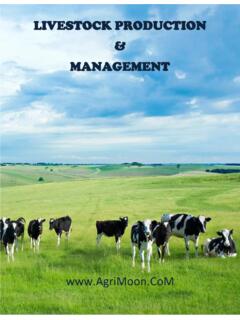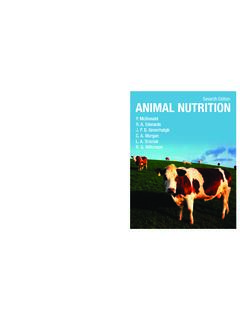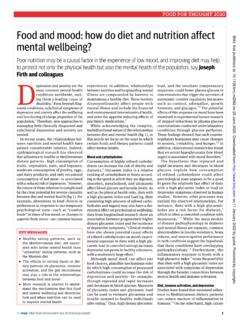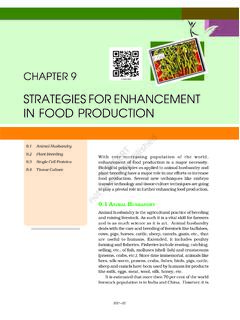Transcription of Poultry Development Review
1 Poultry Development Review The designations employed and the pr esentation of material in this information pr oduct do not imply the expression of any opinion whatsoever on the part of the Food and Agriculture Organization of the United Nations (F AO) concerning the legal or Development status of any country, territory, city or ar ea or of its authorities, or concerning the delimitation of its fr ontiers or boundaries. The mention of specific companies or pr oducts of manufacturers, whether or not these have been patented, does not imply that these have been endorsed or recommended by FAO in pr eference to others of a similar nature that ar e not views expressed in this information pr oduct ar e those of the author(s) and do not necessarily reflect the views or policies of 978-92-5-108067-2 (PDF) FAO 2013 FAO encourages the use, reproduction and dissemination of material in this information pr oduct.
2 Except where otherwise indicated, material may be copied, downloaded and printed for private study, research and teaching purposes, or for use in non-commercial pr oducts or services, pr ovided that appropriate acknowledgement of FAO as the source and copyright holder is given and that FAO s endorsement of users views, pr oducts or services is not implied in any requests for translation and adaptation rights, and for resale and other commercial use rights should be made via or addressed to information pr oducts ar e available on the FAO website ( ) and can be purchased through Development reviewContentsForeword iiithe role of Poultry in human nutrition 1 The role of Poultry in human nutrition 2 The nutritional benefits of chicken meat compared with other meats 4 The importance of Poultry meat and eggs, especially for children and women 5 Increasing the nutrient content of chicken eggs to improve human health 6 The omega-3 fatty acids 7 How important is cholesterol in eggs?
3 8 Poultry and Poultry products - risks for human health 11 Consumption 12 Marketing 15 Slaughtering and processing 18 Poultry housing and management in developing countries 23 Poultry housing and management in developing countries 24 Incubation and hatching 29 Brooding and management of young chicks 32 Housing and management of breeders 34 Housing and management of broilers 37 Housing and management of layers 39 Management and housing of semi-scavenging flocks 41 Poultry waste management in developing countries 45 Poultry waste management in developing countries 46 Poultry manure characteristics 50 Aerosol contamination 52 Location, siting and concentration of Poultry units 54 Slaughterhouse wastes 56 Poultry feed availability and nutrition in developing countries 59 Poultry feed availability and nutrition in developing countries 60 Advances in Poultry nutrition 64 Main ingredients used in Poultry feed formulations 67 Feed supplements and additives 70 Alternative feedstuffs for use in Poultry feed formulations 72 Animal feed safety 76 Poultry genetics and breeding in developing countries 79 Poultry genetics and breeding in developing countries 80 Contribution of indigenous genotypes to production and consumption of Poultry meat and eggs 84iiPoultry Development reviewCommercial selection for meat and egg production 86 Genetic approaches to improved performance in sub-optimal conditions 89 Genetic diversity and conservation of genetic resources 92 Poultry health and disease control in developing countries 95 Poultry
4 Health and disease control in developing countries 96 Emerging pathogens of Poultry diseases 101 Poultry disease diagnosis: field skills and laboratory procedures 103 Site biosecurity and supporting strategies for disease control and prevention 104 Veterinary roles in health and knowledge transfer across a Poultry industry 106 Poultry welfare in developing countries 109 Poultry welfare in developing countries 110 Welfare issues in commercial egg production 114 Welfare issues in commercial broiler production 117 Transport and slaughter of Poultry 119iiiPoultry Development Review ForewordThe Poultry sector is possibly the fastest growing and most flexible of all livestock sectors. Driven primarily by very strong demand it has expanded, consolidated and globalised over the past 15 years in countries of all income levels. Livestock is fundamental to the livelihoods of about one billion of the world s poorest people.
5 Rural Poultry , in particular, is essential for the livelihood of many resource-poor farmers often being the only asset they possess. It makes up about 80 percent of Poultry stocks in low-income food-deficit countries and significantly contributes to: (i) improving human nutrition , providing food (eggs and meat) with high quality nutrients and micronutrients; (ii) generating a small income and savings, especially for women, thus enhancing the capacity to cope with shocks and reducing economic vulnerability; (iii) providing manure for vegetable garden and crop production. The importance of the socio-cultural and religious functions of village Poultry production for smallholder livelihoods, beyond its economic or nutritional importance, is also widely recognized. This publication is a collection of short articles that give an overview of the benefits of Poultry products and information about different aspects of their production.
6 The articles are primarily written to provide information for a general audience rather than for technical experts in the concerned fields of specialization. Originally prepared as separate articles in 2011 for the FAO Poultry production website they are compiled in this document for easy access and role of Poultry in human nutritionPoulTry Development reviewMost eggs that are consumed in developing countries are produced by commercial layer breeds2 Poultry Development Review The role of Poultry in human nutritionThe role of Poultry in human nutritionDavid Farrell, School of Land, Crops and Food Sciences, The University of Queensland, St. Lucia 4072, Queensland, Australia Chicken meat and eggs are the best source of quality protein, and are badly needed by the many millions of people who live in poverty. In sub-Saharan Africa (SSA) and South Asia malnu-trition (poor nutrition ) and undernutrition (inadequate nutrition ) are closely associated with poverty.
7 These conditions affect the immune system. The HIV/AIDS epidemic sweeping through coun-tries in SSA stems partly from extreme poverty and, with it, poor variaTion in consumPTion of Poultry meaT anD eggsA recent survey of several countries found that 34 percent of the people surveyed in South Asia and 59 percent in SSA were suffering from severe energy deficiency (Smith and Wiseman, 2007). Both groups obtained 67 percent of their energy from sta-ple foods (cereal grains, grain legumes, starchy roots and tubers) containing small quantities of only low-quality protein. Their aver-age per capita egg consumption was only 42 per year, compared with a global average of 153. Stunting and wasting in children under five years of age, and slow mental Development were seen mainly in rural areas of SSA. Eight out of ten of those affected were among the poor.
8 Diseases such as kwashiorkor and mar-asmus, both seen in underweight children, are associated with inadequate dietary energy and protein. Pregnant and lactating women and young children are particularly SSA, only 8 percent of dietary energy comes from animal protein, compared with an average of 17 percent in all develop-ing countries, and 28 percent in China. chicken meaT anD eggs: a valuable source of ProTein anD almosT all of The essenTial nuTrienTsChicken meat and eggs provide not only high-quality protein, but also important vitamins and minerals. Worldwide, 2 billion peo-ple depend on rice as their staple food. Most eat polished white rice stripped of many essential fats, the B complex vitamins and several minerals. Other cereal grains are usually deficient in criti-cal nutrients. For example, maize (corn) is a staple food in some regions, but the niacin it contains is unavailable.
9 Maize consump-tion without supplements causes pellagra. Invariably the protein content of grains is low and of poor quality. Net protein utiliza-tion (NPU) is an index of protein quality, calculated by multiplying protein digestibility by biological value. NPU of grains is generally less than 40. Rice is the exception, with NPU of about 60, but it is low in protein ( percent). NPU of chicken eggs is 87. Generally, cereals lack the most important amino acids for humans lysine, threonine, the sulphur-bearing amino acids (methionine and cysteine) and occasionally tryptophan. Eggs and chicken meat are rich in these essential amino are also high in lutein which lowers the risk of cataracts and macular degeneration, particularly among people living in developing the least developed countries, the projected increase in egg consumption between 2005 and 2015 is 26 percent, compared with only percent in the most developed countries (Wind-hurst, 2008).
10 Corresponding annual projections for Poultry meat are percent and percent, respectively (FAOSTATS).aDvanTages of chicken meaT anD eggs comPareD To oTher animal ProTeinsIn developing countries, the diet of people living in cities usually contains more animal protein than that of rural people, mainly because urban people are more prosperous, but also because they generally have access to a wider variety of foods at local mar-kets. In low-income countries, commercially produced chicken meat is well placed to satisfy the demands of a rapidly increasing affluent, middle class who can afford to pay for broiler chickens. Facilities and infrastructure for producing broiler chickens can be established quickly and soon start generating. Not only is chicken meat seen as a healthy meat, but it is also the cheapest of all livestock meats. A major advantage of eggs and Poultry meat as human food is that there are no major taboos on their consumption.

















